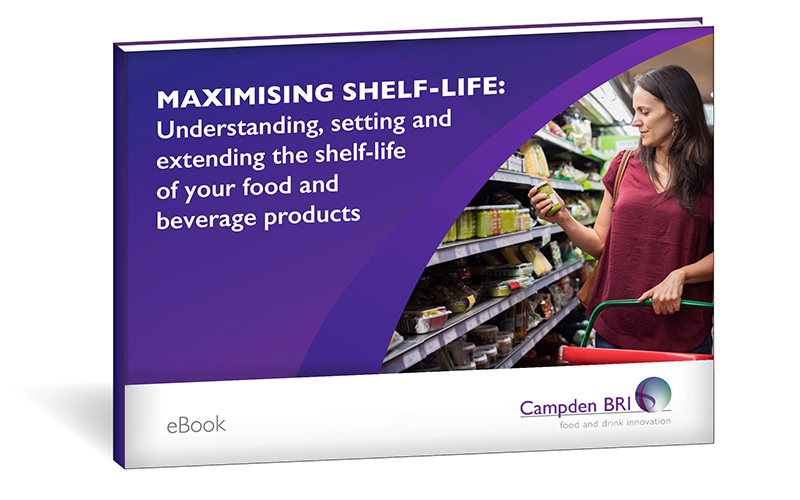
‘Use by’, ‘best before’, ‘display until’ – what’s the difference and why does it matter?
16 January 2023 | Roy Betts, Fellow and Linda Everis, Microbiology Safety and Spoilage Section Lead
A December 2022 poll by the Food Standards Agency (FSA) revealed that 29 % of participant consumers bought ‘yellow sticker’ reduced price food items that are close to their use by date, and 29 % said that they had eaten food past its use by date because they couldn’t afford to buy more. Consuming foods after the use by date means there are potential health risks of getting food poisoning, which could make these consumers seriously ill.
The finding shines a light on the larger issue of date mark confusion as well as the current economic pressures on consumers that could potentially drive more consumption after ‘best before’ and ‘use by’ dates.
Download the complete Maximising Shelf-life eBook, for free, to unlock the tools for measuring and maximising the shelf-life of your food and drink products whilst ensuring their safety and quality.

We’re all aware of the various date marks that appear on food labels, such as ‘use by’, ‘best before’ and ‘display until’, but there are still many who are uncertain about what each of them means. What’s more, some manufacturers are now putting ‘best before’ dates on perishable products, such as milk and yogurt, that would have previously carried ‘use by’ dates in a move to try to reduce food waste.
As a key part of labelling legislation, it’s important to have a good understanding of date marks. Referred to as ‘durability indications’, these date marks include ‘best before’, ‘best before end’ and ‘use by’. Let’s look at what they mean and how they are different from each other.
‘Best before’ – relating to quality
‘Best before’ or ‘best before end’ dates relate to the quality of the food. Foods with this type of indication are safe to eat after the specified date but may not be at their best. For instance, the flavour or texture might not be as it was when the food was first manufactured. ‘Best before’ dates appear on a wide range of foods including those stored / packaged in different ways, for example frozen, dried and canned. The ‘best before’ date is only accurate if the food is stored according to the instructions provided on the product label.
‘Use by’ – relating to safety
A ‘use by’ date is about safety and is applied to foods that, from a microbiological point of view, are highly perishable. If consumed after the date, there is a risk that the food will be unsafe and could cause illness. Foods can be eaten until the end of the ‘use by’ date but not afterwards and the storage instructions provided must also be carefully followed. Foods that display ‘use by’ dates are those that may become unsafe to eat after the end of that date, such as cooked ready-to-eat meat or prepared ready-to-eat salads.
It is a legal requirement that where a ‘use by’ or ‘best before’ date is displayed, the wording provided in relevant legislation must be used and the date must be presented in a specific format depending on the length of the shelf-life.
For products that include a ‘use by’ date, this must be followed by a description of the storage conditions that must be observed to keep the food safely for the specified duration - for example ‘keep refrigerated’. For ‘best before’ indications, instructions on how to store the food are required where special storage conditions are needed to retain the quality of the product, such as ‘store in a dry place, protect from heat’. These storage conditions, for both ‘use by’ and ‘best before’ labelled foods are legal requirements to enable consumers to store the products correctly before the packaging is opened; such information should follow the stated date.
Where consumers may get confused
Other date or duration information that is presented on food labels can cause confusion for consumers, but again some of it is legally required. It is a legal requirement, for example, to provide food storage instructions for when the pack has been opened and where foods require special storage conditions, such as ‘once opened use within 2 days.’ The wording of such indications is, however, not specified. Particular foods, such as frozen meat, frozen meat preparations (e.g. burgers and sausages) and frozen unprocessed fish must be labelled with the date of freezing or the date of first freezing, using the wording ‘frozen on’, followed by the date (day, month and year, in that order). In such cases a ‘best before’ or ‘use by’ indication is still also required.
Indications such as ‘display until’ are not legally required but may be included on food labels to aid stock rotation in retail establishments.
Date marks and the law
Current EU harmonised labelling legislation (Regulation (EU) No 1169/2011 on the provision of food information to consumers, as amended), which has been retained in UK legislation, requires most foods to carry either a ‘use by’ or ‘best before’/‘best before end’ date. It is an offence to sell food after the ‘use by’ date, however, food with an expired ‘best before’ or ‘best before end’ date can still be offered for sale.
Products that do not have to display a date mark
The legislation provides a list of products that do not have to carry a date mark (unless product-specific provisions apply), these include:
- fresh fruit and vegetables, including potatoes, which have not been peeled, cut or similarly treated (except sprouting seeds and similar products such as legume sprouts);
- wines, liqueur wines, sparkling wines, aromatised wines, and similar products obtained from fruit other than grapes, and other specified beverages obtained from grapes or grape musts;
- beverages containing 10% or more by volume of alcohol;
- bakers’ or pastry cooks’ wares which, given the nature of their content, are normally consumed within 24 hours of their manufacture;
- vinegar;
- cooking salt;
- solid sugar;
- confectionery products consisting almost solely of flavoured and/or coloured sugars;
- chewing gums and similar chewing products.
These foods are considered safe either due to an inherent ability to resist microbial growth due to certain physical attributes, such as low pH (vinegar) or low water activity (salt, sugar), a naturally short shelf-life (baked goods), or the fact that spoilage is noticeable and not a safety issue (uncut fresh fruit and vegetables).
‘Use by’ or ‘best before’ – which is it?
It’s important that all food business operators (FBOs) understand the reason they are using either a ‘use by’ or ‘best before’ indication. This decision must be based on the type of product, its ingredients and the processing that it has been subjected to. If an FBO decides to use a ‘best before’ date then they must be certain that there is no risk to consumers if the product is eaten after the specified date (and that means any time period after the end of the date). If a ‘use by’ date is displayed, FBOs must have a valid reason for using that date, and that usually means obtaining and holding data that validates why that date is used.
Catch 22: balancing date marking, consumer preference, high quality and food waste
There’s a bit of a balancing act for manufacturers when it comes to date marking. Conflicting needs from several areas can make putting in place a date mark no easy task. For example, health bodies want less salt, sugar and saturated fat in products to improve consumer health, however some of these ingredients can help to preserve foods, providing a longer life and, in some cases, inhibit microbial growth.
Further considerations come from the wants and needs of the consumers: many want high-quality, fresher foods and clean labels. There’s also the push to reduce food waste, driven by organisations such as WRAP (The Waste and Resources Action Programme). This may be helped by using a longer shelf-life so consumers have more time to consume foods at home, meaning less would be thrown away.
The food safety risk
As can be seen from the above, there are many conflicting issues when it comes to defining the shelf-life of a food. Reducing preservatives (to achieve clean label products) may well reduce shelf-life; consumers want fresher foods and may see longer life as ‘less fresh’, yet the push to reduce waste demands longer shelf-lives. In some cases, it may prompt a move from using ‘use by’ to ‘best before’ on some products (with food safety in mind, of course).
The primary and critical decision must always be one of food safety. We must never increase consumer health risks by our move towards less preserved, longer life products or by a switch to using ‘best before’ rather than ‘use by’ dates. These decisions must only be made after rigorous risk assessments and in many cases obtaining scientific evidence that changes are valid, supported by good science, and do not increase consumer health risk.
So where are we now?
All in all, there’s a lot for FBOs to consider when it comes to date marks. Food producers may need help in defining good, safe durability indications that optimise shelf-life, so that foods are economic to produce and less likely to become waste. Ultimately, the number one priority is, and always has been, to have durability indications that ensure the safety of the product for consumers.
We’re often approached by FBOs who’d like us to investigate their foods (often by looking at the microbiological activity) to help them determine the shelf-life of their products. Our guideline document on determining shelf-life is also available to purchase, to share guidance in this area.
We work extensively helping food producers define the best shelf-life durability indication type to use. We can optimise ‘use by’ dates, help manufacturers determine shelf-life data once the packaging has been opened and back up shelf-lives with required data to ensure foods have a long life but always remain safe to consume. Our regulatory team can also help you in this area. If you have any questions, please get in touch with us.

About Linda Everis
Linda has a wealth of knowledge, experience and expertise from her time in Microbiological Analytical Services and Microbiology Safety and Spoilage. She joined Campden BRI in 1995 as a Senior Technician in the Microbiological Analytical Services group having graduated from the University of Wales Aberystwyth with a BSc in Biology.
Alongside the expert support that Linda provides to our members and clients, Linda conducts project work and research, and has been author and co-author of articles and papers for a variety of microbiological publications and Campden BRI reports.
Linda also lectures on shelf-life, challenge testing and predictive microbiology for our many training courses and seminars.
Guideline 46 (second edition) now available
Our guideline document on determining shelf-life, that is backed by expert advice and practical shelf-life assessment, has recently been updated and is now available to purchase.
How can we help you?
If you’d like to find out more about your product’s shelf-life, contact our support team to find out how we can help.






